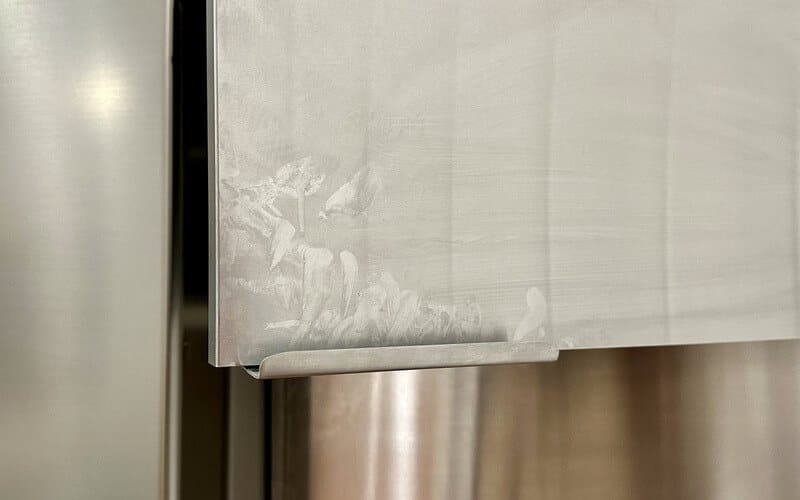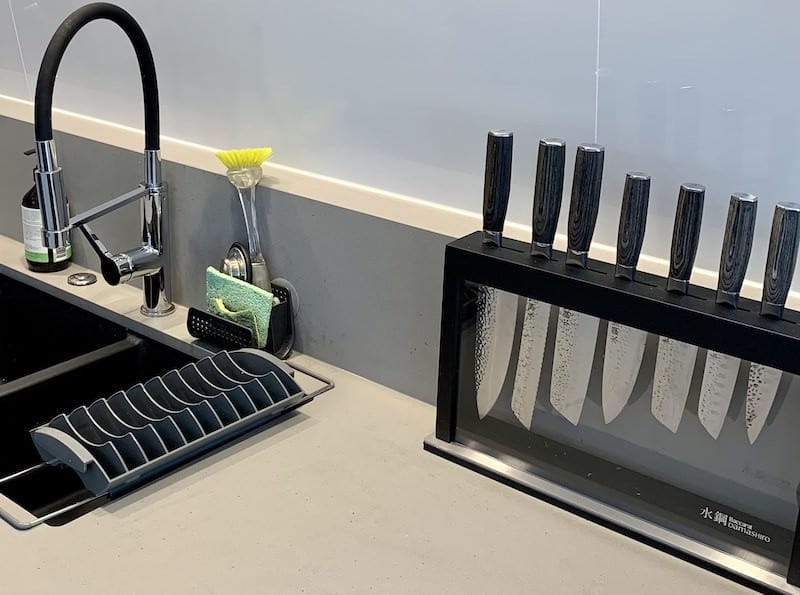Your kitchen has the most stainless steel appliances and fixtures in your home.
It’s also a high-touch, high-traffic area, making it immediately noticeable when things start to look untidy. This can be awkward, especially if guests drop by unannounced!
Fingerprints, water spots and cooking splatters can quickly dull gleaming stainless surfaces. Fortunately, cleaning stainless steel is very straightforward.
Some of the best ways to clean stainless steel include:
- Water and dish soap
- White vinegar and water
- Baking soda paste
- Stainless steel cleaner
Whether it’s a new toaster or the trusty old fridge, here’s your guide to keeping every stainless steel item in your home looking pristine.
What to Clean Stainless Steel With
When cleaning and polishing stainless steel, the best tools and products include:
- Microfibre cloths
- Mild dish soap
- Distilled white vinegar
- Warm water
- Commercial polish or olive oil
For tough stains, opt for specialised cleaning products.
To make a homemade stainless steel cleaner, mix equal parts white vinegar and water in a spray bottle. This works on many stainless appliances, whether for spot cleaning or general cleaning.
Spray on the affected areas, then wipe the surface immediately with a microfibre cloth. Don’t let vinegar sit on stainless steel for long as it can etch the finish.
For stainless steel appliances, make sure to move in the same direction as the grain to avoid scratches or smudge marks. But for sinks, pots, and utensils, you can use a circular motion.
How to Clean Stainless Steel Appliances
Keeping a stainless steel appliance clean means you can use it much longer.
The same cleaning methods apply to stainless steel refrigerators, stoves, dishwashers and even washing machines.
Regular maintenance helps avoid the build-up of grime and fingerprints that can dirty stainless steel surfaces.
This means spot cleaning immediately when spills or splatters happen.
How to clean stainless steel refrigerators

Like most appliances, refrigerators have different materials inside and out.
To clean a stainless steel fridge exterior, use the vinegar cleaning solution on the entire surface. Use a clean microfibre cloth when wiping the fridge dry.
Cleaning the inside of your fridge is a more intensive process that involves emptying the shelves and getting into every nook and cranny.
How to clean stainless steel toasters
Cleaning toasters needs a bit more TLC than, say, washing spoons and forks. For stainless steel models, you can use the same vinegar cleaning solution above.
Most toasters have multiple parts – some of which can be removed, such as the crumb tray and sandwich cage (if yours has one).
These parts can be washed and dried separately, and generally don’t need to be cleaned with any special cleaner.
How to clean a stainless steel dishwasher

Dishwashers feature stainless steel in either the exterior, the tub, or both.
For cleaning a stainless steel dishwasher exterior, use a microfibre cloth with a dedicated steel cleaner or dish soap and water.
When cleaning your dishwasher interior, you can mix a little dish soap in some vinegar and water to scrub the gaskets.
Place a dishwasher-safe container of vinegar in the top rack and run a quick hot water cycle to clean the inside.
How to clean a stainless steel stove top

When cleaning your stainless steel stove top, start by removing any stove grates and wiping away loose debris with a damp cloth.
For everyday cleaning, use a solution of mild dish soap and warm water.
Use a soft sponge to gently scrub the surface, ensuring you move with the grain of the stainless steel to avoid scratching it. Wipe clean with a second microfibre cloth.
For persistent stains, make a paste with some baking soda and water. Use a sponge or soft cloth to apply the paste to the affected areas.
Let it sit for a few minutes, then gently wipe away with a damp microfibre cloth.
Rinse thoroughly with water, then wipe dry with a fresh cloth to leave the surface spotless and shining.
How to Clean Stainless Steel Surfaces and Sinks

Whether in your kitchen or your mudroom, different stainless steel surfaces can get grimy. Here’s how to handle them with care and keep them looking spotless!
Some essential cleaning tools include:
- Soft sponges
- Mild detergent
- Microfibre cloths
- Optional: stainless steel polish
Be sure to rinse with clean water then wipe with a dry cloth to prevent any streaks or water spots.
How to clean stainless steel benches
Cleaning a stainless steel bench is straightforward. First, wipe the surface with a damp cloth to remove any dust or debris.
Mix a mild detergent with warm water and apply it with a soft cloth or non-abrasive sponge, rubbing in the direction of the metal’s grain to minimise scratches.
For sticky residues or more stubborn stains, use a solution of white vinegar and warm water.
After cleaning, rinse the bench well with clean water and dry it with a soft towel to prevent water marks and add shine.
How to clean stainless steel sinks

The best way to clean a stainless steel sink is by using a paste of baking soda and water. Use a gentle scrub brush or sponge to clean off any food gunk and residue.
You can follow up with some vinegar for shine and odour control. Alternatively, a mild dish soap and water will suffice if you’re low on time.
Apply the cleaning solution onto the stainless sink or cookware with a soft sponge and scrub gently.
Rinse thoroughly with water and dry immediately to prevent any water marks from forming.
How to Clean Stainless Steel Cookware and Utensils
Your sink and cookware do a lot of heavy lifting in the kitchen department!
Besides dish soap and water, you can also use vinegar to remove stuck-on food, grease, and other residue.
How to clean stainless steel cutlery
For stainless steel cutlery, regular washing with dish soap and water followed by drying will maintain its appearance.
Polish your stainless steel cutlery to make it shine again, especially before special occasions.
Remember to clean these items after each use to avoid the accumulation of stains and residues.

How to maintain stainless steel pots and pans
Treat your stainless steel pots and pans kindly after every use. Wash them in warm, soapy water and dry them right away to prevent water spots.
For a deeper clean, you can use a dedicated stainless steel cleaner to keep them looking fab.
NOTE: Cleaning cast iron pans is another matter, so please do not follow these instructions if that’s what you’re trying to clean!
How to Disinfect Stainless Steel
To disinfect stainless steel, isopropyl alcohol is your champion!
Apply isopropyl alcohol (70% concentration or higher) with a spray bottle, then wipe the surface with a clean cloth.
You can also use isopropyl alcohol to sterilise cutlery and cookware. However, wash them with dish soap and water afterwards to avoid any potential damage or residue.
How to Remove Stains on Stainless Steel
Despite its name, stainless steel can still get stains, especially if it isn’t cleaned often!
The best way to remove stains is with a baking soda paste. It’s only mildly abrasive, so it won’t scratch the finish.
Mix baking soda with a little water to form a thin paste. Apply this directly to the stained area and let it sit for up to 20 minutes.
Gently scrub the stain with a soft cloth or sponge in the direction of the grain. Rinse thoroughly with water and dry with a clean cloth.
How to Polish Stainless Steel at Home
Polishing stainless steel restores its shine AND adds a protective coating to prevent future smudges and corrosion.
To polish stainless steel, you’ll need:
- Warm water
- Microfibre cloths
- High-quality stainless steel polish or olive oil
Remember to clean the stainless steel item before polishing!
Apply a small amount of your chosen polish to a microfibre cloth and wipe the surface of the stainless steel gently.
Always move in the same direction of the metal’s grain to avoid scratches – this is usually horizontal or vertical.
Use another clean cloth to buff the surface until it shines. You can apply more polish as needed for any tough spots or streaks.
If using olive oil, a few drops on a soft cloth will suffice. Rub it in using circular motions and then buff the surface with another clean, dry microfibre cloth to bring out the shine.
NOTE: Commercial polish (such as polishing paste) is best used for stainless steel appliances and decorative surfaces. It leaves a thin wax layer that lasts several months and makes the surface easier to clean.
For cookware and utensils, opt for olive oil so you don’t contaminate your food.
FAQs About Cleaning Stainless Steel

It won’t hurt to know more about how to clean stainless steel, especially if it’s a brand-new fridge or microwave.
Can you wash stainless steel in the dishwasher?
Stainless steel cutlery and cookware typically withstand the dishwasher well, but it’s best to check the manufacturer’s guidelines.
Arrange your cookware and cutlery in the dishwasher so they do not touch other metals. This helps prevent galvanic corrosion.
Choose a gentle dishwasher detergent that does not contain chlorine to keep the stainless steel in top condition. Remove items promptly after the cycle to prevent water spots.
If needed, give them a quick dry by hand with a microfibre towel to enhance their shine.
NOTE: Please do not put your stainless steel appliances in the dishwasher!
Does white vinegar damage stainless steel?
Not at all – with a caveat! White vinegar is safe for most stainless steel surfaces, and is great for removing hard water stains or food gunk.
However, you shouldn’t let it sit on the material, as the acid can etch the surface. Make sure to rinse it off immediately, either using water or a damp microfibre cloth.
If you’re worried, test your vinegar solution on an inconspicuous area first.
Should I use a proprietary stainless steel cleaner?
For routine cleaning, dish soap and water are your best bets.
But when you need a little extra oomph – like before a house party – a proprietary cleaner can give your stainless steel surfaces a dazzling finish.
Koala Eco’s Stainless Cleaner not only cleans and protects your stainless steel surfaces, it smells great too!
What should you not use on stainless steel?
Avoid using anything with bleach, ammonia, or chlorine as these can corrode a stainless steel surface. The same goes for glass cleaner, which is not formulated for use on stainless steel.
Skip any abrasive materials as well – so no steel wool or harsh scrubbing pads here.
These materials can cause scratches and damage to the finish of your stainless steel, making it more susceptible to rust and staining.
Is carbon steel the same as stainless steel?
Carbon steel is a different material – it has a high carbon content, versus stainless steel which has a high chromium content.
It’s more affordable, but has a lower visual appeal and is more susceptible to rust and corrosion.
Steel These Tips for a Sparkling Clean Kitchen
Think of your kitchen as the heart of your home – it’s bustling from the first cup of coffee to the last bite of dessert.
Cleaning up after each meal, including a wipe-down of stainless steel surfaces, ensures your space remains welcoming and hygienic.
Of course, if you’re feeling daunted or you’d just like to relax, cleaning professionals are just one call away!

